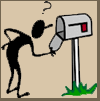Email (or Electronic Mail) is a way of passing messages back and forth between you and your friends and colleagues. It is much more convenient than conventional mail, you do not have to worry about writer's cramp, finding an envelope, finding a stamp and then trying to remember where the post box is. You simply type out your message, ask the server to send it and off it goes!
In order to send email, you need to have an email client/program on your computer to handle this. One of the most popular in use is called Outlook Express.
The first thing you need to do is to compose a message. All outgoing messages need to have an address so that the server will know where to send your message, much the same as you would need for a conventional letter. This usually takes the form of <username>@<domain>, such as CallOnKen@trentham.clara.net.
You have the option to enter a subject line, although this is not strictly necessary but it helps the person receiving the message to know what the message is about.
You can send a message to more than one person at the same time. In
order to do this, you can separate the email address by commas, eg.
fbloggs@clara.co.uk, jsmith@clara.co.uk and the message will go to both
people at the same time.
There is often an option to copy the message to a second recipient,
which means you can send two copies of the message to two different
people at the same time, just as you would by specifying two people
as described above. The difference is simply one of how the message
is intended. Think of the message as being sent to the folks you send
it “To” but being copied (“Cc”) to others for
their information. For instance, you may send an enquiry to the tax
people and send a copy to your accountant so he knows what’s going
on.
You can send files with email. For instance, if you wanted to send your latest poem to your best friend for them to read, you can attach it to the email without having to type the whole thing out again. Your friend can then read the poem when they receive it. Attachments are handled in different ways from one email program to the next and most programs will have a help file to show you how to do this. Be aware, however, that you could send really big files and that would make you very unpopular! Beware in particular of sending pictures.
A signature file is a standard piece of text which is added to the bottom of each email you send out. You may want all of your email to go out with your full name on the bottom or you may wish to have a witty comment put there. Whatever you wish to use as your signature file, most email programs have the facility to do this.
There is little that is more frustrating than having a message sent back to you to say it could not be delivered. Something as small as a comma instead of a full stop in a username can prevent a message from being delivered, but whatever the reason, it will be contained within the message that was sent back to you. Some of the typical error messages are shown below:
This error message has come from the remote server (the server at the other end of the delivery chain) to say that the user to whom the mail was sent does not exist. Maybe you got their address wrong or perhaps their account has been closed down.
unknown local-part "abuse" in domain "man.ac.uk"
Again, this error message has come from the remote server to say that the person to whom the mail was addressed does not exist. This message was originally sent to more than one person.
abuse@curtin.edu.au transcript of session follows
while talking to alpha3.curtin.edu.au:
>>>RCTP To: abuse@curtin.edu.au
<<<553.5.1.1 unknown or illegal user: abuse@curtin.edu.au
550 <abuse@curtin.edu.au>....User Unknown
This message is similar to the above two messages, but looks slightly different. You will notice that all these messages start the same way - they tell you that the message could not be delivered and the reason why.
Recipient address: 109nl1m82sis@internetmci.com
Reason: Not found in directory
This message tells you the same thing again, that the user does not exist at the remote directory.
The following message is slightly different. It simply warns that there are delays in trying to deliver your message and advises at the top that you do not need to resend your message.
THIS IS A WARNING MESSAGE ONLY
YOU DO NOT NEED TO RESEND YOUR MESSAGE
*******************************
The original message was received at Sat, 14 Feb 1998 10:47:46 GMT The following addresses had transient non-fatal errors
abuse@netcom.com
<postmaster@netcom.com> transcript of session follows: <abuse@netcom.com>, <postmaster@netcom.com>..Deferred: Connection reset by netcom20.netcom.com
Message undelivered after 4 hours
Will keep trying until message is 5 days old

